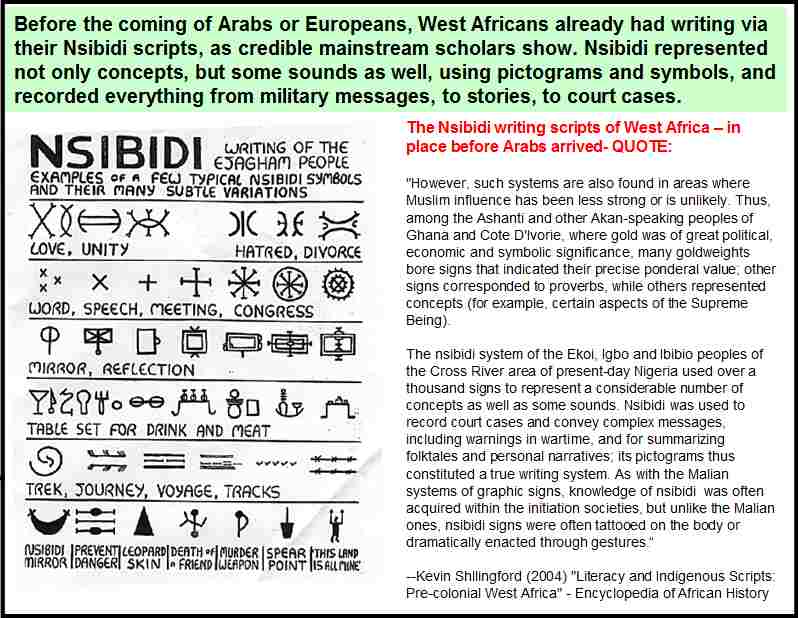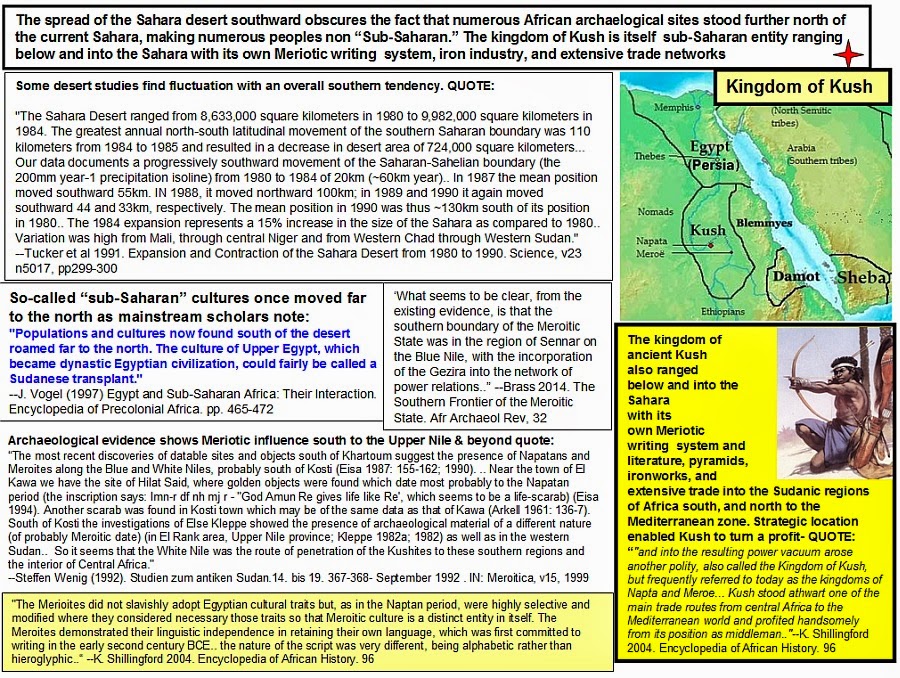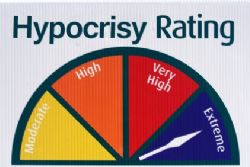melanitex says:
The problem I'm having here it seems that most of the Sub Saharan African Scripts were made relatively recently 1800's - 1900's Vai, N'Ko Akene Script meaning Sub Sahara Africa was illiterate before outside intervention (Europeans, Arabs) etc Nonsense. This view is woefully misinformed on modern African historiography.
African writing scripts have long been around before Islamic and European
times, as already documented by credible mainstream scholars per below.
 "However, such systems are also found in areas where Muslim influence has been less strong or is unlikely. Thus, among the Ashanti and other Akan-speaking peoples of Ghana and Cote D'Ivorie, where gold was of great political, economic and symbolic significance, many goldweights bore signs that indicated their precise ponderal value; other signs corresponded to proverbs, while others represented concepts (for example, certain aspects of the Supreme Being). The nsibidi system of the Ekoi, Igbo and Ibibio peoples of the Cross River area of present-day Nigeria used over a thousand signs to represent a considerable number of concepts as well as some sounds. Nsibidi was used to record court cases and convey complex messages, including warnings in wartime, and for summarizing folktales and personal narratives; its pictograms thus constituted a true writing system. As with the Malian systems of graphic signs, knowledge of nsibidi was often acquired within the initiation societies, but unlike the Malian ones, nsibidi signs were often tattooed on the body or dramatically enacted through gestures."
"However, such systems are also found in areas where Muslim influence has been less strong or is unlikely. Thus, among the Ashanti and other Akan-speaking peoples of Ghana and Cote D'Ivorie, where gold was of great political, economic and symbolic significance, many goldweights bore signs that indicated their precise ponderal value; other signs corresponded to proverbs, while others represented concepts (for example, certain aspects of the Supreme Being). The nsibidi system of the Ekoi, Igbo and Ibibio peoples of the Cross River area of present-day Nigeria used over a thousand signs to represent a considerable number of concepts as well as some sounds. Nsibidi was used to record court cases and convey complex messages, including warnings in wartime, and for summarizing folktales and personal narratives; its pictograms thus constituted a true writing system. As with the Malian systems of graphic signs, knowledge of nsibidi was often acquired within the initiation societies, but unlike the Malian ones, nsibidi signs were often tattooed on the body or dramatically enacted through gestures."--Kevin Shllingford (2004) "Literacy and Indigenous Scripts: Pre-colonial West Africa" - Encyclopedia of African History
Nsibidi covered a wide range of things- from romantic messages to court cases. Historian Ogbu Kalu has described the functions of the Nsibidi literature more broadly to comprise:
“identity label, public notice, private warning, declaration of taboos [and] amorous messages, reckoning of goods and money, and method of keeping of records and decorations.”Kalu, O. 1980. “Writing in Pre-Colonial Africa: A Case Study of Nsibidi.” In African Cultural Development. O. Kalu, ed., 76-83.
---------------------------------------------------------------------------------------
As regards other places in sub-Saharan Africa, both the Kushite alphabetic
script and the Ethiopian Geez systems were also in place before any Arab or
European colonists showed up. Kush/Meroe was a kingdom that extended into
sub-Saharan Africa with trade and admin links, and is a thus a sub-Saharan
entity, and Ethiopia IS in "sub-Saharan" Africa. 
--------------------------------------------------------------------------------------
And Europeans did not invent writing, or alphabets. They copied a writing system
first developed in Africa and modified via peoples of the sub-tropical Middle East,
again as shown by credible mainstream scholars. They are no "role models" as far
as writing. In fact Europe did not even develop is main religion today- the Christian
religion. That too came from sub-tropical peoples of the "Middle East" and North Africa.
Eurocentric hypocrites on this score are many but they are easily exposed
-----------------------------------------------------------------------------
Sticks, stones, and shadows: building the Egyptian
pyramids[/b]

QUOTE:
"Discoveries by Gunter Dreyer of the German Archaeological
Institute suggest that the origin of Egyptian writing needs to be
reexamined, offering the possibility that the idea of writing was
developed in Egypt several centuries before it occurred in the
Near East. Inscriptions from hundreds of pots and labels found
at the royal cemetery at Abydos show some hieroglyphic writing
as far back as 3400 BCE, with most occurring about 3200 BCE.
Sumerian writing seems to have begun about 3100 BCE. The
Egyptians formed and used writing in a different way than the
Asians. The linguistic pictographs of Sumer were rudimentary
were used primarily used for commerce. Those of Egypt were
more representational of real objects and were primarily
employed to identify kings, tombs and the like.
A remarkable find involving early experiments with alphabetic
writing in Egypt has been recently made by John C. Darnell, an
Egyptologist at Yale University, and his wife Deborah. Inscriptions
discovered in the limestone cliffs on an ancient road between
Thebes and Abydos, a route once heavily traveled by Asian
traders and mercenaries in the Egyptian desert, are in a Semitic
script with Egyptian influences. Dated between 1900 and 1000 BCE,
they are two or three centuries older than previous evidence of
an alphabet in the Semitic-speaking territory of the Sinai Peninsula
or in the Syria-Palestine region occupied by the Canaanites. While
there have always been indications that Semites were inventors of
the alphabet, researchers had heretofore assumed that it was
developed in their own lands by borrowing and simplifying Egyptian
hieroglyphs. Instead Darnell's discovery now suggests that, working
with Semitic speakers in Egypt, native scribes simplified formal
pictographic Egyptian writing and modified the symbols into an
early alphabet using a semi-cursive form commonly used in the
Middle Kingdom."
ENDQUOTE- from:
--Martin Isler (2001). Sticks, stones, and shadows: building the
Egyptian pyramids. Univ of Oklahoma PRess. p. 56